A
Auto Express
Guest
Verdict
Just a little more range would make the Honda e more appealing, but it’ll likely be fine for how most owners will use it. What you can’t deny is that Honda’s execution is superb; the e drives nicely, it’s comfortable, refined and even fun. It lacks a little practicality, but the tech and style on offer is pretty much unsurpassed on the compact EV market. It’s not without fault, but this is a strong first foray into the world of modern electrification from Honda.
Meet the Honda e, the Japanese brand’s first electric car for Europe – and doesn’t it look cool? Honda’s Urban EV Concept wowed crowds when it was revealed at the 2017 Frankfurt Motor Show, and while in transformation to production form the Honda e has lost a few smart styling cues, it’s still a great-looking little EV.
This continues inside, because the cabin is dominated by an infotainment screen that spans the full width of the dash. It comprises an 8.8-inch TFT panel in front of the driver showing data such as speed and efficiency, while two 12.3-inch touchscreens make up the main infotainment display.
There are five screens in total, with two six-inch displays at either side of the dash showing the picture from the door-mounted cameras that replace conventional wing mirrors. They ape the traditional units in their shape, and the two screens are well placed, while the resolution of the picture is sharp and there’s very little delay between what’s happening outside and what you see on the screen. They work better than the similar tech used in much more expensive cars, such as the Lexus ES, and you get used to them quickly.
The infotainment is mostly slick, too. The screens are bright and the sharpest we’ve seen in a Honda. Response to your inputs is good, but while the gallery view you get from the dash-wide display is lovely – especially on its home screen, where you can load your own images – the left panel is a bit of a reach from the driver’s seat.
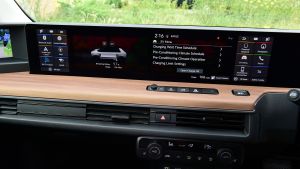
image
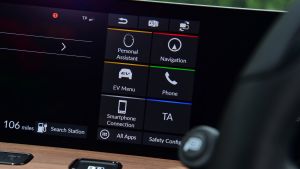
image
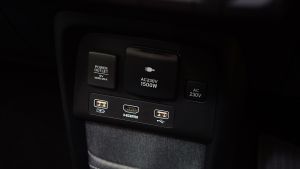
image
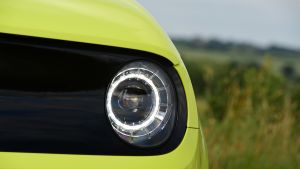
image
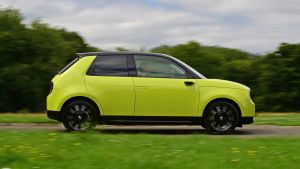
image
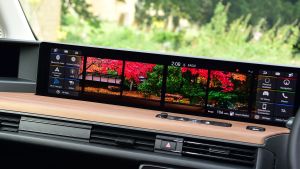
image
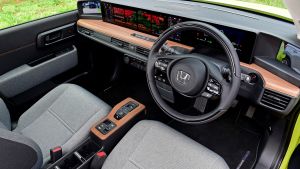
image
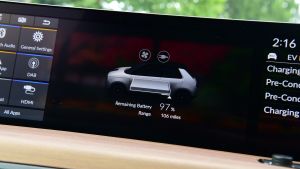
image
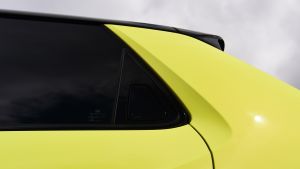
image

image
Top-spec Advance models feature everything you’d need: climate and adaptive cruise control, a rear-view camera, parking sensors with auto-park tech, a heated steering wheel and seats, Honda Connect nav with CarPlay and Android Auto, LED lights, four USB points to keep your gadgets charged and a better stereo with a subwoofer.
There’s also autonomous braking with collision warning, blind-spot monitoring with cross-traffic alert, lane-departure warning, lane-keep assist and road- departure mitigation, so with lots of standard safety tech the e should keep you safe – especially in town, where it’ll likely spend a lot of its life.
Which brings us to how the Honda behaves in an urban environment. The 35.5kWh battery supplies a 152bhp electric motor driving the rear wheels, but with 315Nm
of torque, this gives the car its character. Despite that sizeable torque output, the e doesn’t feel as punchy as some rivals. Honda claims 0-62mph takes 8.3 seconds, but as with any EV, it’s really the performance from 0-30mph that makes more of an impact. The car is quick enough, with Sport mode sharpening throttle response slightly.
You get a sense of being propelled from the rear rather than being dragged from the front, but the big benefit is that with no motor in the nose, the e’s steering lock and turning circle are seriously impressive. It can turn 180 degrees in a street just 8.6 metres wide, so this urban EV is brilliantly manoeuvrable and a doddle to park.
The steering is quite light, but it’s quick, and combined with the relatively short wheelbase, the e feels agile. The heavy battery is mounted in the floor, so the centre of gravity isn’t too high and the car feels stable, even through quicker corners.

image

image

image

image

image

image

image

image

image

image
There’s great grip, too, not least because the e wears Michelin Pilot Sport 4 tyres, which give more bite than you might expect an EV such as this to have. On the plus side, they don’t seem to unduly affect the ride quality or refinement either.
Over patchy road surfaces the Honda feels a little jiggly, but when you hit a bigger bump, the thud never arrives since the suspension softens the blow. The ride is more settled at higher speeds, but it’s certainly not busy or nervous around town. It’s more comfortable than pretty much any petrol-powered supermini on sale today – and it’s a lot quieter, too.
There’s very little motor whine and no wind whistle. In fact, one of the loudest sounds you hear is when the pop-out handles automatically snap back into the doors as you put the car into Drive.
A simple button-press gear selector is fitted, while the centre console also features a switch to increase brake regeneration. You can use the steering wheel paddles to flick through the different modes, too, and these ramp up the strength to the point where you can drive using just one pedal.
It’s powerful enough to bring the car to a stop without touching the brakes, and with good anticipation, one-pedal driving is easy. Gaining energy back is useful too, because while there are many positives to the Honda e, it’s hard to ignore its small 35.5kWh battery and modest 137-mile range. Rivals such as the Renault Zoe and Vauxhall Corsa-e can go much further; the Honda is more closely aligned with the MINI Electric for price and range.

image

image

image

image

image

image

image

image

image

image
The Honda accepts 50kW rapid charging, so an 80 per cent charge takes 30 minutes, while a Type 2 cable is standard, so a full top-up from a home wallbox takes around nine hours and 15 minutes. You also get a three-pin cable to drip-feed the car from a conventional socket – but it’ll likely only be for emergency use, because a full charge this way takes around 14 hours and 45 minutes.
There’s some under-floor storage, but not enough for both cables, so Honda supplies two bags. This eats into the already-small 171-litre boot, but remember that the short range means this isn’t a car designed for long trips, so its boot capacity should be perfectly adequate most of the time.
At least room in the rear is good. You sit upright, made possible by the tall roofline, which brings your legs back towards you, effectively creating more space in front.
The e is only a four-seater, but it’s spacious enough for short to medium trips (with that range, you won’t be in the car for hours anyway), while the interior is nicely executed. The wood finish on the dash, brown seatbelts and cool grey cloth upholstery (it seems like Honda has made a thing of not having leather, and it works) all look great and carve the e out as a cool, advanced and modern electric car.
Continue reading...
Just a little more range would make the Honda e more appealing, but it’ll likely be fine for how most owners will use it. What you can’t deny is that Honda’s execution is superb; the e drives nicely, it’s comfortable, refined and even fun. It lacks a little practicality, but the tech and style on offer is pretty much unsurpassed on the compact EV market. It’s not without fault, but this is a strong first foray into the world of modern electrification from Honda.
Meet the Honda e, the Japanese brand’s first electric car for Europe – and doesn’t it look cool? Honda’s Urban EV Concept wowed crowds when it was revealed at the 2017 Frankfurt Motor Show, and while in transformation to production form the Honda e has lost a few smart styling cues, it’s still a great-looking little EV.
This continues inside, because the cabin is dominated by an infotainment screen that spans the full width of the dash. It comprises an 8.8-inch TFT panel in front of the driver showing data such as speed and efficiency, while two 12.3-inch touchscreens make up the main infotainment display.
There are five screens in total, with two six-inch displays at either side of the dash showing the picture from the door-mounted cameras that replace conventional wing mirrors. They ape the traditional units in their shape, and the two screens are well placed, while the resolution of the picture is sharp and there’s very little delay between what’s happening outside and what you see on the screen. They work better than the similar tech used in much more expensive cars, such as the Lexus ES, and you get used to them quickly.
The infotainment is mostly slick, too. The screens are bright and the sharpest we’ve seen in a Honda. Response to your inputs is good, but while the gallery view you get from the dash-wide display is lovely – especially on its home screen, where you can load your own images – the left panel is a bit of a reach from the driver’s seat.

image

image

image

image

image

image

image

image

image

image
Top-spec Advance models feature everything you’d need: climate and adaptive cruise control, a rear-view camera, parking sensors with auto-park tech, a heated steering wheel and seats, Honda Connect nav with CarPlay and Android Auto, LED lights, four USB points to keep your gadgets charged and a better stereo with a subwoofer.
There’s also autonomous braking with collision warning, blind-spot monitoring with cross-traffic alert, lane-departure warning, lane-keep assist and road- departure mitigation, so with lots of standard safety tech the e should keep you safe – especially in town, where it’ll likely spend a lot of its life.
Which brings us to how the Honda behaves in an urban environment. The 35.5kWh battery supplies a 152bhp electric motor driving the rear wheels, but with 315Nm
of torque, this gives the car its character. Despite that sizeable torque output, the e doesn’t feel as punchy as some rivals. Honda claims 0-62mph takes 8.3 seconds, but as with any EV, it’s really the performance from 0-30mph that makes more of an impact. The car is quick enough, with Sport mode sharpening throttle response slightly.
You get a sense of being propelled from the rear rather than being dragged from the front, but the big benefit is that with no motor in the nose, the e’s steering lock and turning circle are seriously impressive. It can turn 180 degrees in a street just 8.6 metres wide, so this urban EV is brilliantly manoeuvrable and a doddle to park.
The steering is quite light, but it’s quick, and combined with the relatively short wheelbase, the e feels agile. The heavy battery is mounted in the floor, so the centre of gravity isn’t too high and the car feels stable, even through quicker corners.

image

image

image

image

image

image

image

image

image

image
There’s great grip, too, not least because the e wears Michelin Pilot Sport 4 tyres, which give more bite than you might expect an EV such as this to have. On the plus side, they don’t seem to unduly affect the ride quality or refinement either.
Over patchy road surfaces the Honda feels a little jiggly, but when you hit a bigger bump, the thud never arrives since the suspension softens the blow. The ride is more settled at higher speeds, but it’s certainly not busy or nervous around town. It’s more comfortable than pretty much any petrol-powered supermini on sale today – and it’s a lot quieter, too.
There’s very little motor whine and no wind whistle. In fact, one of the loudest sounds you hear is when the pop-out handles automatically snap back into the doors as you put the car into Drive.
A simple button-press gear selector is fitted, while the centre console also features a switch to increase brake regeneration. You can use the steering wheel paddles to flick through the different modes, too, and these ramp up the strength to the point where you can drive using just one pedal.
It’s powerful enough to bring the car to a stop without touching the brakes, and with good anticipation, one-pedal driving is easy. Gaining energy back is useful too, because while there are many positives to the Honda e, it’s hard to ignore its small 35.5kWh battery and modest 137-mile range. Rivals such as the Renault Zoe and Vauxhall Corsa-e can go much further; the Honda is more closely aligned with the MINI Electric for price and range.

image

image

image

image

image

image

image

image

image

image
The Honda accepts 50kW rapid charging, so an 80 per cent charge takes 30 minutes, while a Type 2 cable is standard, so a full top-up from a home wallbox takes around nine hours and 15 minutes. You also get a three-pin cable to drip-feed the car from a conventional socket – but it’ll likely only be for emergency use, because a full charge this way takes around 14 hours and 45 minutes.
There’s some under-floor storage, but not enough for both cables, so Honda supplies two bags. This eats into the already-small 171-litre boot, but remember that the short range means this isn’t a car designed for long trips, so its boot capacity should be perfectly adequate most of the time.
At least room in the rear is good. You sit upright, made possible by the tall roofline, which brings your legs back towards you, effectively creating more space in front.
The e is only a four-seater, but it’s spacious enough for short to medium trips (with that range, you won’t be in the car for hours anyway), while the interior is nicely executed. The wood finish on the dash, brown seatbelts and cool grey cloth upholstery (it seems like Honda has made a thing of not having leather, and it works) all look great and carve the e out as a cool, advanced and modern electric car.
| Model: | Honda e Advance |
| Price: | £29,160 (after Govt. grant) |
| Battery/range: | 35.5kWh/137 miles |
| Power: | 152bhp |
| Transmission: | Single-speed automatic, rear-wheel drive |
| 0-62mph: | 8.3 seconds |
| Top speed: | 90mph |
| Range: | 3.6 miles per kWh |
| CO2: | 0g/km |
| On sale: | Now |
Continue reading...
